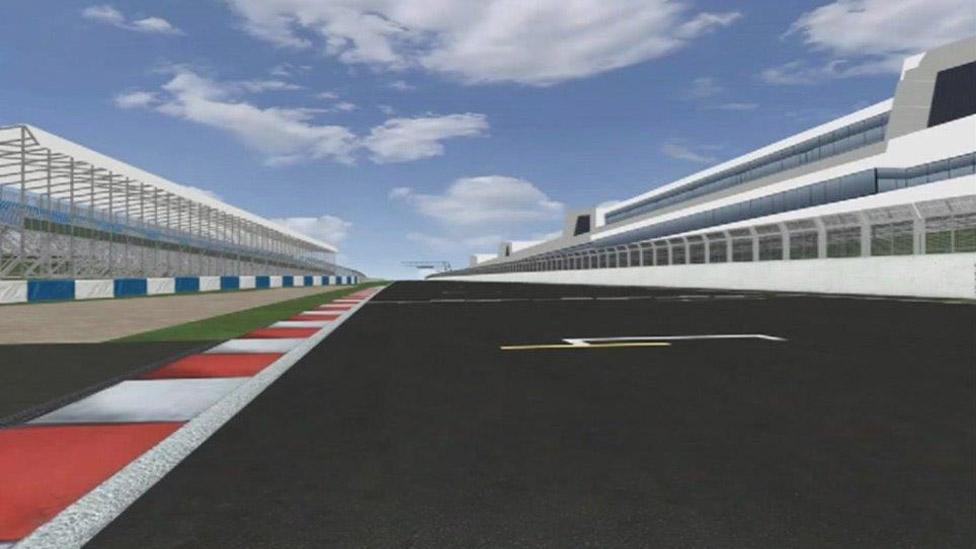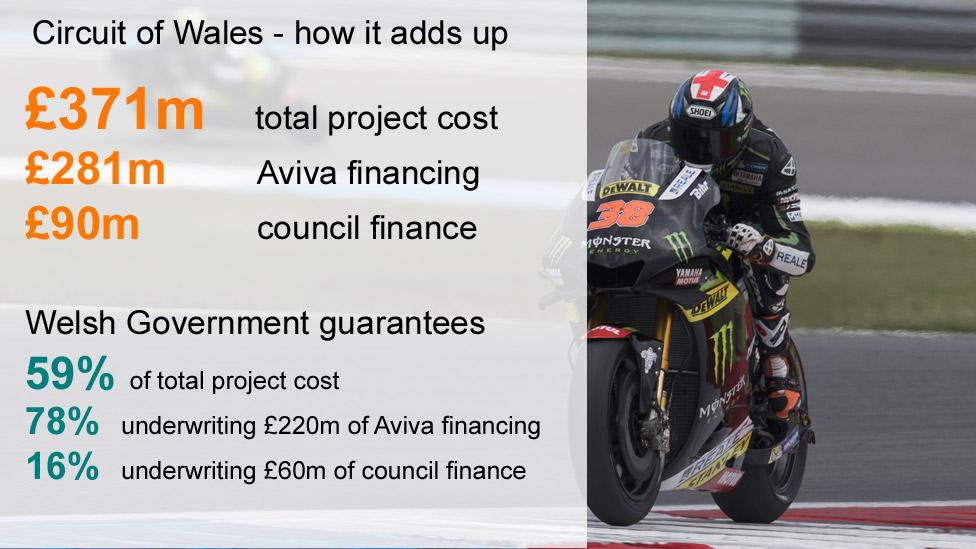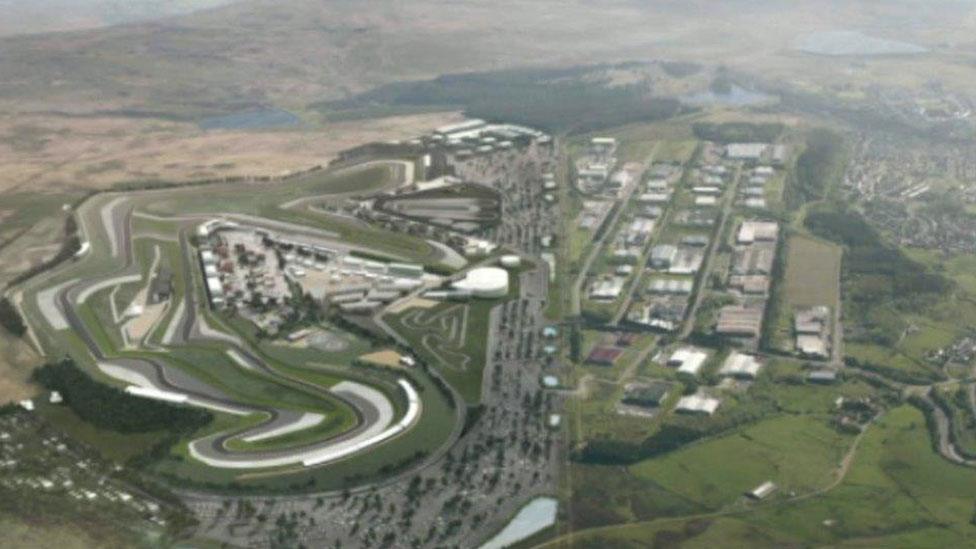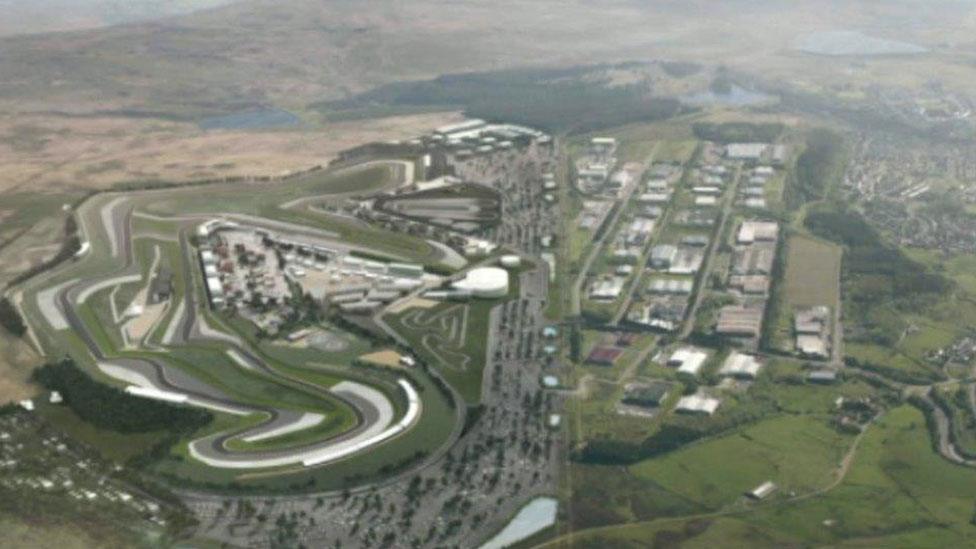How much risk is the Circuit of Wales in Ebbw Vale?
- Published

A CGI image of how the Circuit of Wales would look
Nearly five years after the ambitious plans were first unveiled, the Circuit of Wales in Ebbw Vale faces its latest hurdle.
The developers hoped this would be the final obstacle to the diggers starting work at the heads of the valleys.
Now they will have to come back again with another proposal if they want financial guarantees from Welsh Government, one that does not involve an "unacceptable level of risk".
When it comes to the crunch, it has all been about risk and perception of risk.
Would benefits from the 830 acre regeneration, with its planned race track, hotels and industrial developments, outweigh the risk to the Welsh public sector - Welsh Government and local authorities - underwriting half of the £371m project? That is the nub of it.
The latest proposal from the developers, Heads of the Valleys Development Ltd, is that Circuit of Wales carries the risk during construction.
But after the project has been built, the public sector underwrites half of the cost.
In return the Welsh Government would be paid £125.4m over 33 years - equivalent to £3.8m a year.

This is how the project cost breaks down and the guarantees as proposed to the Welsh Government
Under the plan, insurance giant Aviva is putting in £281m for 33 years and sharing the long-term operating risk.
Since the 2008 financial crisis there have been many examples of the public and private sectors working together to enable projects to happen.
Examples include improvements to rail services or to generate energy.
Here, estimating the revenue is relatively easy to calculate or forecast, so there is less risk.
IS THERE A PRECEDENT?

Friars Walk opened with the help of a council loan
If you look a few miles away in Newport, the council there lent developers £90m to ensure the Friars Walk shopping centre was built.
Newport council - with an idea from Birmingham - borrowed the money from the Public Works Loan Board at a lower rate of interest and then lent it on to the developers in a "calculated risk" to ensure the project was built.
"Everything in life is risky but we were at an impasse when the developer was unable to raise the funds in the money markets because of the interest rates," said then council leader Bob Bright at the opening of the shopping centre in November.
JUDGING THE RISK

The main sticking point for a public/private sector agreement about the funding of the Circuit of Wales is how to reliably forecast incomes streams from the various elements of the vast regeneration project.
There is a 10-year deal to host the British MotoGP motorcycling event. But how many events will there be at the circuit? How many people will buy tickets to go? How many automotive component firms will set up there? Will two hotels be built and how many people will stay there?
Even though there are many ways of offsetting and judging risk - or whether it is too risky to bear - it is not an exact science.
In the end it can come down to a subjective decision.
Former Conservative AM William Graham was involved in all the negotiations, up to May, as chairman of the enterprise and business committee.
He said he did not think Wales could lose out on the opportunity.
"Things like this don't come about very often," he said.
"Their (Labour's) policy is to raise people out of poverty. What could be better? Even if it didn't produce 6,000 jobs, even 600 in Ebbw Vale is a huge bonus.
"It is one of the few schemes that really excites people outside Wales. The motorbike racing family is enormous in Europe and there's no reason why it would not work.
"An awful lot of major projects involve underwriting and it won't be operable until the building is finished.
"The risks are low until that time and there's a saleable asset. So really the Welsh Government has every assurance that their contribution is likely to be minimal. Their risk is being repaid by nearly £4m a year for 30 years."
For borrowing, better rates of interest were possible if the Welsh Government, in theory, was underwriting it.
CAN THE WELSH GOVERNMENT AFFORD THE RISK?
"Even though there is an element of risk, there's also the social side of it," says Mr Graham.
"A scheme of this kind would make an enormous difference to the individual lives of people in Ebbw Vale. It really would make a difference, what else is going to help them?"
- Published13 July 2016

- Published6 April 2016

- Published29 April 2016

- Published7 April 2016
